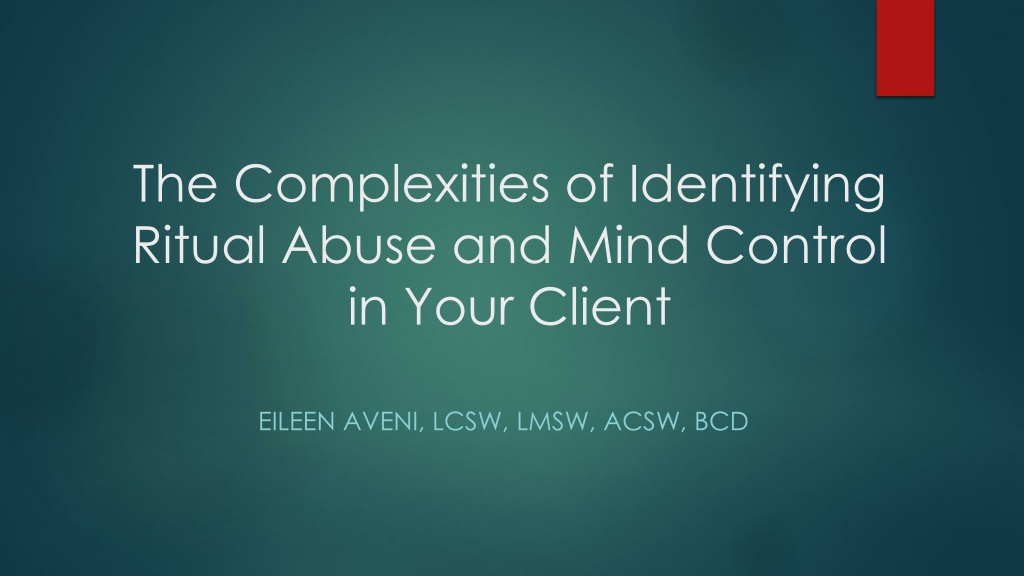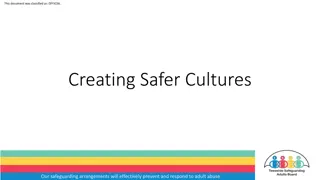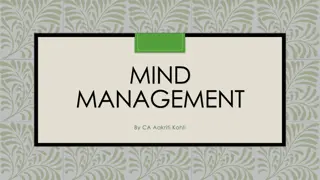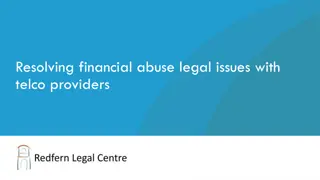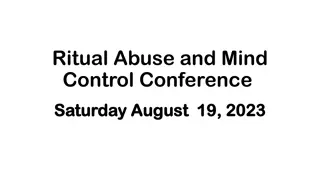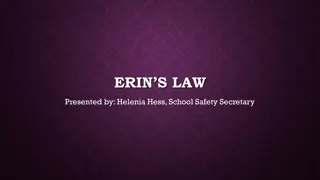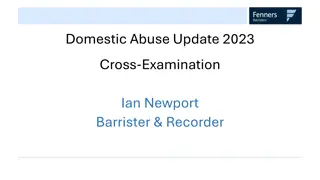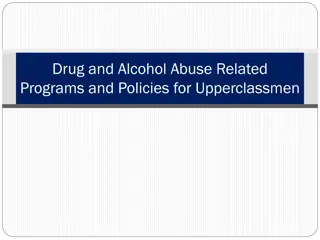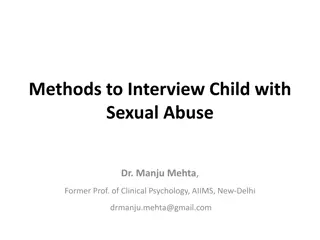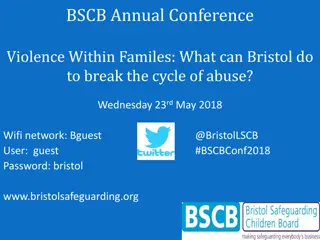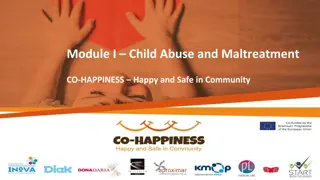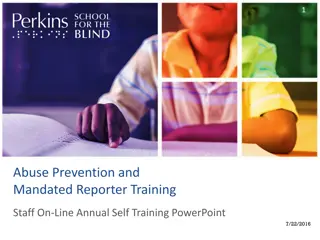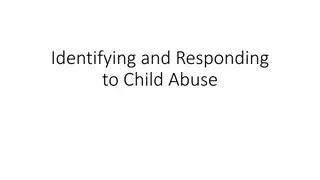Understanding Ritual Abuse and Mind Control in Clinical Practice
Identifying ritual abuse and mind control in clients can be complex, with common indicators such as dissociative identity disorder and extreme trauma experiences. The Extreme Abuse Survey highlighted significant findings related to ritual trauma, including global prevalence, involvement in organized crime and clergy abuse, and the effectiveness of healing methods. Therapists must be skilled, observant, and open to understanding and supporting survivors of extreme abuse.
Download Presentation

Please find below an Image/Link to download the presentation.
The content on the website is provided AS IS for your information and personal use only. It may not be sold, licensed, or shared on other websites without obtaining consent from the author. Download presentation by click this link. If you encounter any issues during the download, it is possible that the publisher has removed the file from their server.
E N D
Presentation Transcript
The Complexities of Identifying Ritual Abuse and Mind Control in Your Client EILEEN AVENI, LCSW, LMSW, ACSW, BCD
Identifying Ritual Abuse (RA) & Mind Control (MC) Complex but there are common indicators. Most survivors will have many of these common indicators or clues. But the presence of any of these clues does not prove that RA and MC has occurred. It s the combination of clues, plus the client s actual experience that will further clarify what has really occurred in the client s life. A therapist must: Be skilled in DID treatment or be supervised by a therapist skilled in DID treatment. Be extremely observant. Always be open to the possibility that your client may have gone through extreme trauma and may be scrutinizing you to know if you are willing to walk with them. Be unwilling to keep your client and only do the minimum or what is comfortable for you. Be willing to refer out OR be willing to learn from others, most especially experts in the field.
Extreme Abuse Survey (EAS) An International Online Survey for Adult Survivors of Extreme Abuse) January 1 March 31, 2007. By Wanda Karriker, Ph.D, Thorsten Becker, Carol Rutz, Bettina Overcamp, Ph.D. 2337 persons viewed the survey; 1719 in English, 618 in German. 1471 persons answered at least one question on the survey. 31 countries were declared: United States (774); Germany (273); United Kingdom (92); Canada (75); Australia (38); Switzerland (13); Israel (11); Norway (10); etc. 124 respondents did not name a country of residence. Of those who responded to the question asking if they had ever been threatened with death if they ever talked about the abuse, 77% indicated yes. Of those who responded to the question asking if they have had dissociative flashbacks with satanic themes, 68% indicated yes. Of those who responded to the question asking if their ritual abuse had originated from their family of origin, 63% indicated yes.
Ten EAS Findings Helpful to Understanding Ritual Trauma (W. Karriker) 1. Ritual abuse/mind control (RA/MC) is a global phenomenon. 2. A diagnosis of Dissociative Identity Disorder is common for persons who report histories of RA/MC. (84% of EAS respondents who answered that they have been diagnosed with DID [N=655] reported that they are survivors of RA/MC). 3. Ritual abuse (RA) is not limited to SRA, i.e., satanic ritual abuse, sadistic abuse, satanist abuse. 4. RA is reported to involve mind control techniques. 5. Some extreme abuse survivors report that they were used in government-sponsored mind control experimentation (GMC).
Ten EAS Findings Helpful to Understanding Ritual Trauma (W. Karriker) [2] 6. RA/MC is reported to be involved in organized known crime. 7. RA/MC is reported to be involved in clergy abuse. 8. Most often reported memories of extreme abuse are similar across all surveys. 9. Most often reported possible aftereffects of extreme abuse are similar across all surveys. 10. In rating the effectiveness of healing methods, therapists tend to favor stabilization techniques; survivors are more open to alternative ways to cope with indoctrinated belief systems.
Deliberately-created Internal Personality System Mind Control Multiple perpetrators, large organized crime networks. Thus Organized Abuse. RA & MC & OA = RAMCOA Focused torture to achieve certain goals of the perpetrator group(s). Person can be high-functioning, tightly wound, well-groomed OR underachiever, struggling in life. Internalized perpetration to keep person under control - personality parts are taught to punish each other for divulging information about the abuse. More complex internal structures from mind-control to ensure compliance and reliability.
Deliberately-created Internal Personality System Mind Control [2] Mind Control Programming: To never be discovered, To undermine or sabotage therapy, To be more complex to resolve - thus confusing - if you don t know the process of treatment and recovery. To cover up the crimes and thus protect the perpetrators. Perpetrator groups have professional mind control experts who are hired, move around to different groups, are paid well to achieve flawless victims. Usually misdiagnosed, thus treatments for other diagnoses do not resolve the underlying problems. Some personality parts are also spontaneously created by the survivor.
Ritual Abuse/Mind Control (RA/MC) Patterns Many patterns exist due to the different goals of perpetrators. Sophisticated, Organized Cults Multi-generation families who may take on leadership. Basic Lower-level Cults Gangs. May/may not be multi- generational, not in leadership. Specific Needs Cults Sex trafficker, drug ring leader, assassin, breeder, messengers, military soldiers, government mind control, and more.
Common Mind Control Programs Self-Injury Programs (cutting, burning, failure to eat, accident prone, ingest injurious materials, failure to sleep. Lethal Programs (suicide, may have many suicide programs in the personality system). Assassination Programs (cult may trigger a part to kill someone who is a threat or liability like a supportive significant-other, or may want to discredit the survivor to weaken their power in the cult, frame them and thereby flush them out of the cult and into the penal system. The cult group may give them the weapons).
Common Mind Control Programs [2] Cult-control Programs (reporting, accessing, return back or call back, reminder/reinforcement programs). Therapy Interference Programs (scrambling, flooding, recycling, cover programs, verbal response acceptable language to the cult, silence/shutdown, nightmare/night terror, isolation, pain, rapid switching, not see, not think, stay distracted, become obnoxious, mistrustful, or resistant to the therapist).
Symptoms (Clues) of RA and MC with DID Depression and anxiety, substance abuse, sexual problems. Personality changes and amnesia. Large gaps in memory, often for an entire year or more of one s childhood. No memory for particular past places of residence. History of significant suicidality, often beginning in childhood or following attempted disclosure. Suicidal feelings feel disconnected from one s own thoughts, not their own true feelings. Client appears relieved after remembering a troubling incident in their history but then exhibits suicidal/self-harm behavior soon after. Increased depression, anxiety, self-harm, or suicidality on holidays, birthdays, equinoxes, solstices, Halloween (All Hallow s Eve, All Souls Day), holidays that a given cult celebrates, etc. Dread for one s own birthday.
Symptoms (Clues) of RA & MC with DID [2] Client has unusual fears and phobias - water, fear of bathing, being underwater, snakes, spiders, rats, rain may feel as if it is burning (hot or like acid), darkness, red meat, any food that is brown (reminds of bodily processes), enclosed places, being placed underground, in coffins, in dark holes, in cages. Fears, phobias, or nightmares associated with religion, e.g., priests, churches, crosses, Christmas, demons, angels, God, etc. Sensitive to indoor lights, need bright lights to be turned off or dimmed. Fear responses to benign stimuli, e.g., indoor lights and mirrors (very common), colors, shapes, animals, hearing one s name called, cartoon characters, etc. Unexplained behavioral compulsions, i.e. strong need to eat or drink a particular thing, go to a particular place, perform a particular act, etc. Chronic stress-related disorders (fibromyalgia, lupus, arthritis, eczema, asthma, etc.) Headaches. Sudden need to leave home for the evening, weekend, longer.
Symptoms (Clues) of RA & MC with DID [3] Views self as an accomplice or as evil. When producing art, draws abuse or torture themes, eyes, child or children stuck somewhere (enclosed spaces, etc), babies, spiders, triangles, nested triangles, number sequences, uses mostly red and black art mediums to draw. Fears of movie projectors or film lights. Feelings of hopelessness, excessive crying, often sounding/whining like a child. Can t seem to be consoled. Strong advocate for animal rights. Loves pets, an obsession. Increased phone calls (but no one answers to hello ) around birthdays or ritual holidays. To not wish for anything,
Therapeutic Resistance Clues of RA & MC Any memories of trauma is usually followed by a statement like: I must have made it all up. Any progress in therapy or memories that surface increase suicidality, self-harm (burns, drug overdose, cuts watch for patterns in cutting), depression, anxiety. Need to cancel the next session following a disclosure, urges to stop therapy. Sleepiness in therapy, lost time, feeling the need to go somewhere else inside while in a session. inability to speak or hear the therapist. Calls, or contact from family, or handler(s) to client following a session. May sound benign to the therapist but client appears to be reacting or making decisions. Headaches or other physical pain, esp. following a disclosure or to derail the session. Includes ongoing or intermittent pains which can t seem to be medically diagnosed. Severe flinching and spasms (as if being electro-shocked) when approaching trauma material.
Government-sponsored Mind Control Project MkUltra or MK-ULTRA was a mind-control program developed by the US government, under the guidance of Nazi scientists who were covertly imported to train our government to combat the Cold War against Soviet Union. Nazi scientists were developing mind control in the concentration camps by experimenting on prisoners. Attempted to create a super Aryan race utilizing drugs, torture, and brainwashing, etc. US theorized that they needed people who could be extraordinary in espionage work. Monarch Programming is a continuation of project MK-ULTRA. Methods are incredibly sadistic. Results in a mind-controlled slave (man or woman) who can be triggered at anytime to perform any action required by the handler. Used by sex traffickers in the sex slave industry, and in the entertainment industry (sex slaves are known as Beta alters and Beta models). Used by the military in the Delta program as assassins, professional killers, special ops.
Symptoms or Clues of Monarch/MkUltra Mind Control Obsession with numbers, sequences of numbers, singing the same song, robotic thoughts. Obsession with the butterfly image (tattoos, drawings, etc.). Psychic driving feeling (coming from when the person was subjected to a continuously repeated audio message on an endless looped tape to alter their behavior, a method developed by Ewen Cameron, MD). Feeling that there are inanimate, mechanistic, mathematical, or laboratory-like objects in the mind or elsewhere in the body. Feeling drugged when coming near memories. Clients exhibit symptoms of electroshock abuse. Alice in Wonderland programming and Wizard of Oz programming ( Falling down the Rabbit Hole, Follow the yellow brick road ) - used to build and control a Monarch slave. Repetitive, robotic statements that do not make sense in context of dialogue, e.g., I want to go home (Wizard of Oz).
Assessment THINGS TO LOOK FOR AS YOU DO INITIAL INTERVIEWS AND GET TO KNOW YOUR CLIENT (6 MONTHS TO 1 YEAR OR MORE)
1. Level of functioning in daily life Educated, good family life, good job, goals in life, maybe church- going with positions held in the church, positions of influence in the community, etc. Underachiever, basic job or no job, attempts to get ahead but seems to sabotage self or others sabotage them, preoccupied with basic survival. Diagnoses possibly present (i.e. Borderline, Depression, OCD, phobias, anxieties, Bipolar, eating disorders, etc.).
2. Family background Dysfunctional family vs perfect family (or it seems that way) Dysfunctional family - feuds, relationships severed, multiple marriages/affairs, lots of chaos in relationships, some sibs very successful while others very dysfunctional and acting out, cruelty, no loyalty, secrecy, incest, abuse, violence, substance abuse. Perfect family too perfect, driven, consistent push to succeed, leaders in the town, closed family system where others outside know little about what really goes on inside the family. Secrecy with incest and other abuses inside family system. A few fall short of the family expectations, are cut off from family. Ancestral line of leaders OR of more dysfunctional patterns. Some may have died of mysterious circumstances. Multiple births twins, triplets, etc. in the line.
3. Geographical area where they were born/grew up Where were they born? All levels of the cult are aware that some locations are more hallowed, more revered, come with more power and possible future success for a future cult member. Some go out of their way to have the birth take place there. Where did they grow up? There are hotbeds of cult activity everywhere. The location will tell us what the cult was like, the goals they may have for members, and how sophisticated the group may be. For example: In the U.S. Michigan, Wisconsin, Minnesota, North Dakota, upstate New York, and Kansas City continue to be hotbeds as they are carry-overs from the migration from northern Europe where RA had the most foothold in the cultures there. Kansas City ranks high because of being the center of the US and on the Mississippi river (much lore with that river); Fire Island, NY; certain mountainous land formations, Indian burial mounds, places where 3 rivers intersect, etc. British Isles, Scandinavia, Germany, Canada, and Australia seem to have a significant population of RA & MC survivors. Many other locations in the US, Canada, and the world. Therefore - look for geographical oddities, special land, or RA history. Some will be accessed no matter where they live.
4. How they spent their vacations growing up Interesting question? Does the person remember vacations? Memory lapses except for maybe only good things. Asking more questions may provoke discomfort. When were they taken? Over known cult holidays? Close to a big cult holiday? Where did they go? Pay attention to the location - i.e. known cult area? Same extended family each time? Where? One cult s mechanism might be to strategically implant and reinforce programming periodically and usually over cult holidays. The rest of the year is off limits. Other cults may implant and/or reinforce programming all around the year.
5. Perpetrator(s) single, small group, organized network ring Does the person have clear memory of a single or small group of perpetrators? Do they sound sophisticated or is it a group getting some kicks? Some clients will be able to identify what happened, memories may come out in stilted fashion, but will come without mind control interference. With Organized Network Rings - clients are fraught with a host of symptoms as they even come near the memory. Is it just PTSD delayed reaction? Or is it mind control preventing the memory from coming forward? Switching may occur.
6. Presentation chaotic/distressed, active switching, voices, phobias, etc. Does the client present as chaotic, distressed, maybe unkempt, actively switching, hearing voices, even imperceptibly? Or do they present as well-controlled, well-groomed with perhaps a marriage problem or something else unrelated to a deep-seated trauma in their background? Do they exhibit another mental health problem like depression, OCD, etc? Is that a correct diagnosis? Does the client report that they have some phobias (i.e. beef, hates the color red, maybe black or purple, claustrophobic, fear of flying, fear of bugs, fear of cameras, fear of snakes, other odd fears? When reporting any of these things, does the client appear uncomfortable talking about it?
7. Changes in emotional state As you interview and explore, are there changes in facial expression, glazed eyes, forgets the last question you asked, tightening of the throat, nervous twitching of the body, a look like they are listening to something else (inside voice maybe?), reactionary/belligerent behavior to push back at the therapist, RA survivors almost never cry over things we might cry over. But their body language gives away their discomfort over perhaps: Not being allowed to tell or break secrets from the cult. Feeling programming kicking in to flood and overwhelm, shut down talking, internally perpetrate anyone inside who might betray the cult, switch to a different alter to allow relief or to present differently to the therapist so the therapist doesn t catch on that anything is wrong.
8. Seasonal switching/rotation of parts Some internal systems rotate around the year at the change of seasons. Especially true of those who grew up in the northern parts of the US where there are 4 seasons. Not common in regions without full differentiated seasons. Groups that have a history in fertility cults are usually based on seasons. Other groups can use this model as well. Many parts in this kind of system are grouped by season and only appear in that season. Usually the internal system will have an internal self helper that stays year round and knows everyone. They are a kind of gate-keeper who is useful to eventually help the entire system recover. Leading up to the seasonal switch, there is usually chaos in the system. If it s winter time, ask if they are aware of what they did last summer? Or another time of the year? Did the client grow up in a 4-season region but now lives somewhere else?
9. Front part (shell?) in denial or acceptance? Front part is also known as the Apparently Normal Personality (the ANP). In high cults or specific needs cults, the ANP may be a shell to present a normal personality to the world. Essential to their role and function within the cult. This person usually has no understanding of their relationship to any cult. They are clueless. The front part may not be a shell. There could be flawless rotations of parts that also allow the person to present as a normal personality. To the observer, sometimes the person may not finish sentences and appear to think very fast, faster than they can speak. Other than that, they routinely rotate flawlessly. This is high cult. The front part could also realize that they are losing time, be classically switching and be in distress about it. They are struggling to accept being DID.
10. Indicators of programming (reporter alters, reactions to therapy, etc.) Over time, there may be indicators of programming that are present in the client. The ANP reports to family member (or whoever is in charge of them, such as their handler) Calls or cards from family or perps at strategic times (like before a therapy appointment), losing time since last appointment, sudden change in attitude about therapy, changes in behavior since a ritual date that may have passed, etc. It is essential to work with the reporter alters from the beginning to prevent them from reporting back to the cult, even if the person has supposedly been out of the cult for years.
11. Working directly with parts vs. working through the ANP Some clients actively switch in a session. Parts come out and communicate with the therapist. Some clients work with their parts while the parts remain internally hidden in the back. But some clients could be switching in almost imperceptible ways. To the trained therapist, subtle switches of vocal tone, facial movements, eye movements, body repositioning, etc., may give it away. Try asking permission to work directly with a given part.
29 12. Detecting switches In early therapy, clients may switch subtly. Language may change. Content may change while voice sounds the same. Word salad speech indicates rapid switching. Emotional state may be quite different. Ask if this is someone new, if they know you, if they know where they are. If you suspect it s a child part, ask the age so you can communicate appropriately.
30 13. Detecting co-presence You may sense a change in emotional state. Ask Is someone else here? I sense someone is feeling scared Is that you or someone else? Can you tell them who I am and where we are so they won t be so scared? Always assume more than one part is present.
14. Active involvement in group This is difficult to determine in the beginning of treatment. RA/MC clients have: Internal perpetrators who punish if the client tells anything always true in deliberately created systems. Multiple layers of programming kick in one after another or simultaneously especially true for those whose function was destined to be very valuable. This may lead the therapist to believe that the client is cult-active. The client could be cult-active if behaviors change at ritual date times including: Memory lapses, parts out that weren t out before while others were stuffed inside, Serious physical abuse occurs, Reactivation of programming that had been successfully dismantled such as agreements that were made with reporter alters but now changed, Evidence of reprogramming that was done.
15. Role level within perpetrator group For high cult members, leadership is their destiny: To influence culture, the arts, entertainment, politics, youth, the church, world events, etc. Baby-breeders for sacrifices or future use, sex slaves. Professional programmers hired out to other groups. Key professionals in all places in society to carry out activities and keep the cover-up going (police, judges, doctors, funeral directors, political figures, porn film industry leaders, etc.) For low or specific needs members, roles may include: Baby-breeders for sacrifices or future use, drug runners, money-launderers, sex traffickers, sex slaves. Assassins, professional programmers, espionage work, military secret storage and retrieval. Women s cult leaders, spiritual leaders within churches, synagogues, and occult activities, etc.
16. Internal Structures Always assume there is an internal hierarchy of parts with those at the top in control while those under them do their bidding. As work progresses in therapy, there may be evidence of other internal structures at work in the system such as: geometric structures, spider webs, mirrors, upside down pyramids, prisms, Monarch, government mind control. These structures reflect an organized, more sophisticated cult group. The programmer can then place deliberately created parts into these structures in organized ways to easily locate them later and call out parts or groups of parts for certain tasks. The client may surface memories or phobias about these structures, or draw pictures with these images on them. Parts may also refer to them. These are keys to later understand and unravel how the system was put together.
DID vs. Schizophrenia Schizophrenia DID Identity alteration acting like a different person. o Identity confusion inner struggle about one s identity. o Amnesia states time loss, memory problems. o Rapid switching (in DID) mistaken for schizophrenic (or BPAD). Word salad disorganized speech. Auditory hallucination inside and outside the head but more likely to hear more than 2 voices, including children & adults, beginning before 18 yrs. old. o Word salad disorganized speech. o o Auditory hallucinations inside & outside the head. o May decompensate to a dissociative-like psychosis but is not transient. o May decompensate to a dissociative psychosis but as a transient crisis state. o Lesser capacity to develop a working therapeutic alliance. o Has a greater capacity to develop a working therapeutic alliance. o Reports of past events taken as hallucinations. o Reports of actual past events can be misinterpreted by therapist as hallucinations. o
DID vs. Bipolar Affective Disorder (BPAD) BPAD Rapid changes in speech and thought (BPAD Mania). DID o o Rapid changes in speech and thought (RAMCOA switching). Reckless and self-destructive behavior can occur, though it may not be remembered by an RAMCOA survivor. o Reckless and self-destructive behavior can occur. o Depressed mood, low energy, concentration, suicidal thoughts. o Depressed mood, low energy, concentration, suicidal thoughts. o Hyperactivity, impulsiveness, irritability, rapid changes in speech and thought (Switching behaviors). o Hyperactivity, impulsiveness, irritability, rapid changes in speech and thought (BPAD Mania). o Time loss (amnesia) of any trauma history. o Memory not affected. o
DID vs. Bipolar Affective Disorder (BPAD) [2] BPAD DID o DID has an environmental basis early childhood trauma not chemical imbalance or genetic. Primary treatment: therapy, processing trauma, learning to cooperate with alters. Medication often does not help. o BPAD has genetic, environmental, and biochemical basis. Primary treatment: medication (mood stabilizers); therapy helps manage stress and deal with the effects of living with BPAD. Auditory hallucinations are a common symptom of DID. They are not attributed to psychosis, they are the voices of alters being heard by the host. In BPAD, however, auditory hallucinations are attributed to psychosis and are treated with anti- psychotic medications. o o
DID Assessment Tools SCID-D - Structured Clinical Interview for Dissociative Disorders to detect whether a person is experiencing dissociative symptoms and/or a dissociative disorder. Can take three to five hours. DES-II - Dissociative Experiences Scale-II A 28-question self-test developed as a screening test for Dissociative Identity Disorder. Can be completed in 10 minutes and scored in less than 5 min. DDIS - The Dissociative Disorders Interview Scale DSM 5 Version - a highly structured interview that makes DSM 5 diagnoses of somatic symptom disorder, borderline personality disorder and major depressive disorder, as well as all the dissociative disorders. It inquires about positive symptoms of schizophrenia, secondary features of DID, extrasensory experiences, substance abuse and other items relevant to the dissociative disorders. The DDIS can usually be administered in 30-45 minutes. Further evaluation by a therapist very skilled in DID and RA/MC evaluation and treatment. On-going supervision by a skilled DID and RA/MC therapist. Join a local DID, RA/MC study group, OR the ISSTD Ritual Abuse, Mind Control, and Organized Abuse (RAMCOA) Special Interest Group.
